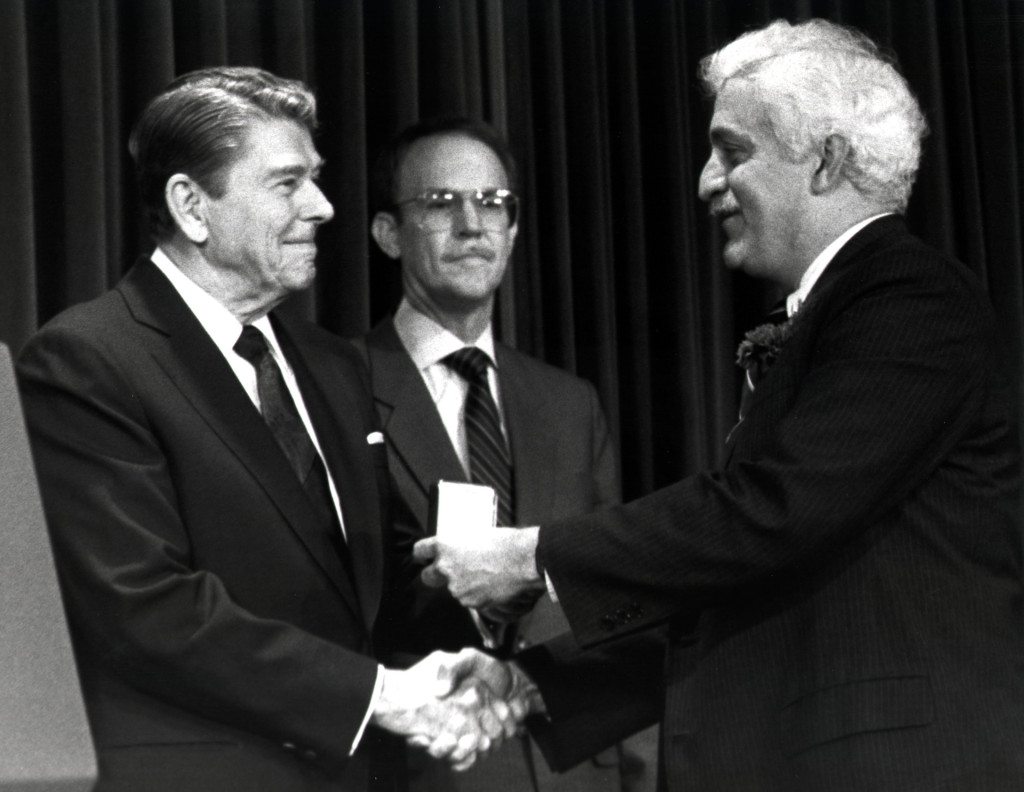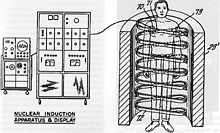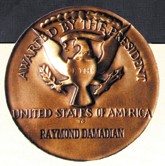By George B. Kauffman
According to the late Ulf Lagerkvist, a member of the Swedish Academy
of Sciences who participated in judging nominations for the Chemistry
Prize, “It is in the nature of the Nobel Prize that there will always be
a number of candidates who obviously deserve to be rewarded but never
get the accolade.” Usually, a losing candidate merely accepts the
injustice. But in the case of the 2003 Nobel Prize in Physiology or
Medicine of $1.3 million, awarded 10 years ago to University of Illinois
Chemist Paul C. Lauterbur (1929-2007) and University of Nottingham (UK)
Physicist Sir Peter Mansfield (b. 1933) “for their discoveries
concerning magnetic resonance imaging,” the undoubtedly deserving
candidate, Raymond Vahan Damadian, M.D. (b. 1936), an American of
Armenian descent, did not take this injustice lying down.
A group called “The Friends of Raymond Damadian” protested the denial
with full-page advertisements, “The Shameful Wrong That Must Be
Righted” in the New York Times, Washington Post, the Los Angeles Times,
and Stockholm’s Dagens Nyheter. His exclusion scandalized the scientific
community, in general, and the Armenian community, in particular.
Damadian correctly claimed that he had invented the MRI and that
Lauterbur and Mansfield had merely refined the technology. On Sept. 2,
1971, Lauterbur had acknowledged that he had been inspired by Damadian’s
earlier work.
Because Damadian was not included in the award, even though the Nobel
statutes permit the award to be made to as many as three living
individuals, his omission was clearly deliberate. The possible purported
reasons for his rejection have included the fact that he was a
physician not an academic scientist; his intensive lobbying for the
prize; his supposedly abrasive personality; and his active support of
creationism. None of these constitute valid grounds for the denial.
The careful wording of the prize citation reflects the fact that the
Nobel laureates did not come up with the idea of applying nuclear
magnetic resonance (NMR) (the term was later changed to avoid the
public’s fear of the word “nuclear,” even though nuclear energy is not
involved in the procedure) to medical imaging. Today magnetic resonance
imaging (MRI) is universally used to image every part of the body and is
particularly useful in diagnosing cancer, strokes, brain tumors,
multiple sclerosis, torn ligaments, and tendonitis, to name just a few
conditions. An MRI scan is the best way to see inside the human body
without cutting it open.
The original idea of applying NMR to medical imaging (MRI) was first
proposed by Damadian, a physician, scientist, and an assistant professor
of medicine and biophysics at the Downstate Medical Center State
University of New York in Brooklyn. Growing up in Forest Hills, N.Y., he
attended the Julliard School and became a proficient violinist. When he
was still a boy, he lost his grandmother to a slow death by cancer. He
vowed to find a way to detect this dreaded disease in its early, still
treatable stages.
MRI scanners make use of the fact that body tissue contains lots of water (H2O), and hence protons (1H
nuclei), which will be aligned in a large magnetic field. Each water
molecule contains two protons. When a person is inside the scanner’s
powerful magnetic field, the average magnetic moment of many protons
becomes aligned with the direction of the field. A radio frequency
current is briefly turned on, producing a varying electromagnetic field.
This electromagnetic field has just the right frequency, known as the
resonance frequency, to be absorbed and flip the spin of the protons in
the magnetic field. After the electromagnetic field is turned off, the
spins of the protons return to thermodynamic equilibrium and the bulk
magnetization becomes realigned with the static magnetic field. During
this relaxation, a radio frequency signal (electromagnetic radiation in
the RF range) is generated, which can be measured with receiver coils.
Information about the origin of the signal in three-dimensional space
can be obtained by applying additional magnetic fields during the scan.
These additional magnetic fields can be used to generate detectable
signals only from specific locations in the body (spatial excitation)
and/or to make magnetization at different spatial locations precess at
different frequencies, which enables http://en.wikipedia.org/wiki/K-space_(MRI)
encoding of spatial information. The 3D images obtained in MRI can be
rotated along arbitrary orientations and manipulated by the doctor to be
better able to detect tiny changes of structures within the body. These
fields, generated by passing electric currents through gradient coils,
make the magnetic field strength vary depending on the position within
the magnet. Protons in different tissues return to their equilibrium
state at different relaxation rates.
Using a primitive NMR machine, Damadian found that there was a lag in T1 and T2
relaxation times between the electrons of normal and malignant tissues,
allowing him to distinguish between normal and cancerous tissue in rats
implanted with tumors. In 1971, he published the seminal article for
NMR use in organ imaging in the journal Science (“Tumor Detection by
Nuclear Magnetic Resonance,” March 19, 1971, vol. 171, pp. 1151-1153).
Nevertheless, many individuals in the scientific and NMR community
considered his ideas far-fetched, and he had few supporters at this
time.
However, Damadian received a grant from the National Institutes of
Health (NIH) in 1971 to continue his work. He proposed to use whole body
scanning by NMR for medical diagnosis in a patent application,
“Apparatus and Method for Detecting Cancer in Tissue,” filed on March
17, 1972 (U.S. Patent No. 3789832, issued Feb. 5, 1974). By February
1976, he was able to scan the interior of a live mouse using his FONAR
(field focused nuclear magnetic resonance) method.
In 1977, using his machine christened “Indomitable,” now preserved in
the Smithsonian Institution in Washington, D.C., Damadian tried to scan
himself, but the test failed because of his excessive weight. On July
3, 1977, he obtained the first human NMR image—a cross-section of his
slender postgraduate assistant Larry Minkoff’s chest, which revealed
heart, lungs, vertebræ, and musculature. Minkoff had to be moved over 60
positions with 20-30 signals taken from each position. Congratulatory
telegrams poured in from all over the world, including one from
Mansfield.
In early 1978, Damadian established the FONAR Corporation in
Melville, N.Y., to produce MRI scanners. Later that year he completed
his design of the first practical permanent magnet for an MRI scanner,
christened “Jonah.” By 1980 his QED 80, the first commercial MRI
scanner, was completed.
The MRI imaging industry expanded rapidly with more than a dozen
different manufacturers. On Oct. 6, 1997, the Rehnquist U.S. Supreme
Court awarded him $128,705,766 from the General Electric Company for
infringement of his patent.
Damadian is universally recognized as the originator of the MRI (by
President Ronald Reagan, among others) and has received numerous
prestigious awards such as the National Medal of Technology in 1988, the
same year he was inducted into the National Inventors Hall of Fame. He
was named Knights of Vartan 2003 “Man of the Year,” and on March 18,
2004, he received the Bower Award from the Franklin Institute of
Philadelphia for his development of the MRI.
George B. Kauffman is Professor Emeritus of Chemistry at California State University, Fresno, Calif.
Sunday, November 10, 2013
Subscribe to:
Post Comments (Atom)




No comments:
Post a Comment